University Report: Singapore's Innovation and Productivity Trends
VerifiedAdded on 2021/04/24
|21
|4308
|88
Report
AI Summary
This report examines the economic challenges faced by Singapore due to a declining population and its implications on innovation and productivity. It analyzes the dynamics of global population growth and the specific demographic trends in Singapore, including the aging population and shrinking workforce. The report explores the economic consequences of these trends, such as increased economic dependency and decreased productivity. It highlights the government's strategies and policies to address these issues, including research incentives, training grants, and initiatives to promote technological advancements and innovation to maintain economic prosperity. The report concludes by emphasizing the importance of boosting productivity through innovation to counteract the negative effects of population decline and ensure sustainable economic growth. It also discusses future policies and incentives to be implemented.
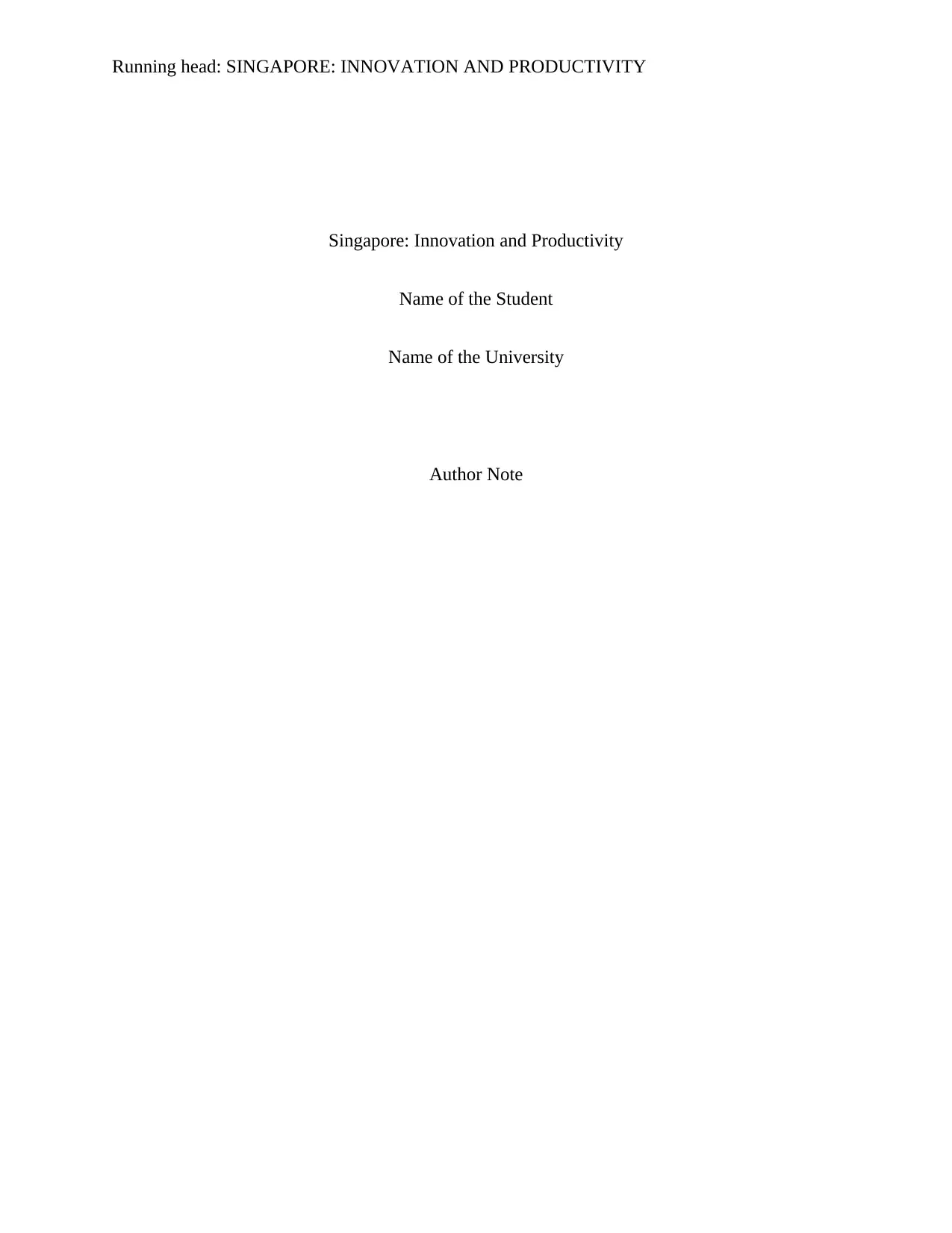
Running head: SINGAPORE: INNOVATION AND PRODUCTIVITY
Singapore: Innovation and Productivity
Name of the Student
Name of the University
Author Note
Singapore: Innovation and Productivity
Name of the Student
Name of the University
Author Note
Paraphrase This Document
Need a fresh take? Get an instant paraphrase of this document with our AI Paraphraser
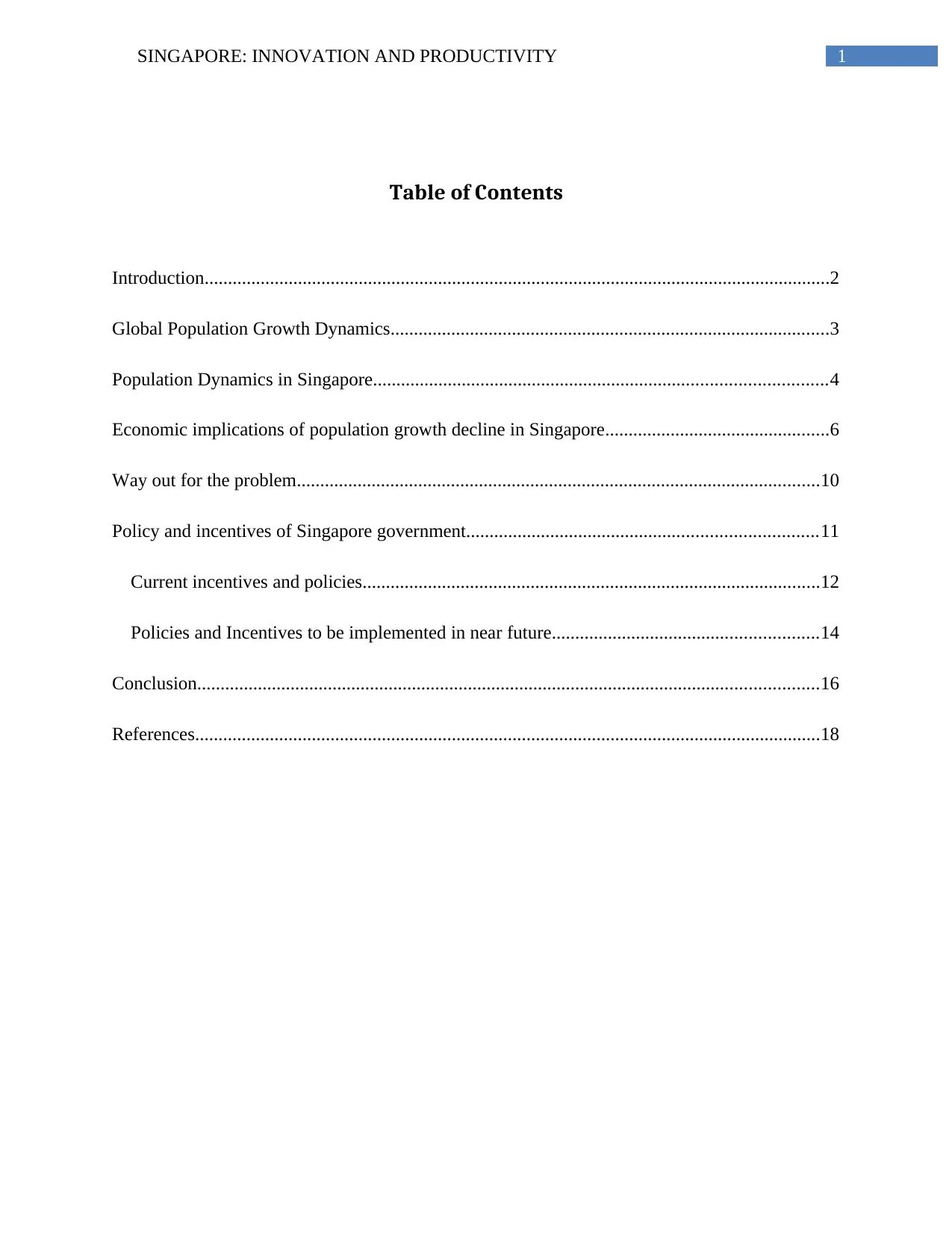
1SINGAPORE: INNOVATION AND PRODUCTIVITY
Table of Contents
Introduction......................................................................................................................................2
Global Population Growth Dynamics..............................................................................................3
Population Dynamics in Singapore.................................................................................................4
Economic implications of population growth decline in Singapore................................................6
Way out for the problem................................................................................................................10
Policy and incentives of Singapore government...........................................................................11
Current incentives and policies..................................................................................................12
Policies and Incentives to be implemented in near future.........................................................14
Conclusion.....................................................................................................................................16
References......................................................................................................................................18
Table of Contents
Introduction......................................................................................................................................2
Global Population Growth Dynamics..............................................................................................3
Population Dynamics in Singapore.................................................................................................4
Economic implications of population growth decline in Singapore................................................6
Way out for the problem................................................................................................................10
Policy and incentives of Singapore government...........................................................................11
Current incentives and policies..................................................................................................12
Policies and Incentives to be implemented in near future.........................................................14
Conclusion.....................................................................................................................................16
References......................................................................................................................................18
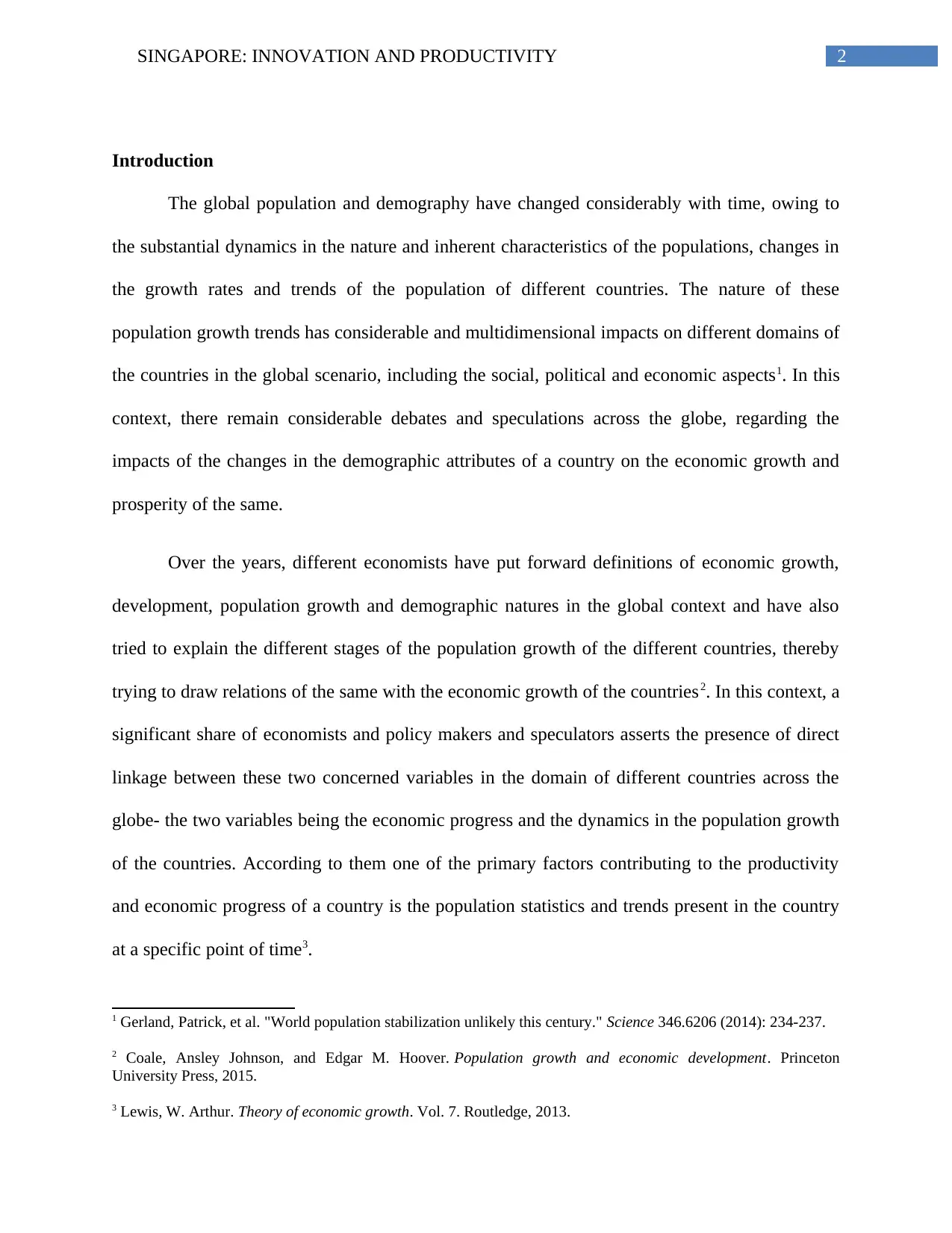
2SINGAPORE: INNOVATION AND PRODUCTIVITY
Introduction
The global population and demography have changed considerably with time, owing to
the substantial dynamics in the nature and inherent characteristics of the populations, changes in
the growth rates and trends of the population of different countries. The nature of these
population growth trends has considerable and multidimensional impacts on different domains of
the countries in the global scenario, including the social, political and economic aspects1. In this
context, there remain considerable debates and speculations across the globe, regarding the
impacts of the changes in the demographic attributes of a country on the economic growth and
prosperity of the same.
Over the years, different economists have put forward definitions of economic growth,
development, population growth and demographic natures in the global context and have also
tried to explain the different stages of the population growth of the different countries, thereby
trying to draw relations of the same with the economic growth of the countries2. In this context, a
significant share of economists and policy makers and speculators asserts the presence of direct
linkage between these two concerned variables in the domain of different countries across the
globe- the two variables being the economic progress and the dynamics in the population growth
of the countries. According to them one of the primary factors contributing to the productivity
and economic progress of a country is the population statistics and trends present in the country
at a specific point of time3.
1 Gerland, Patrick, et al. "World population stabilization unlikely this century." Science 346.6206 (2014): 234-237.
2 Coale, Ansley Johnson, and Edgar M. Hoover. Population growth and economic development. Princeton
University Press, 2015.
3 Lewis, W. Arthur. Theory of economic growth. Vol. 7. Routledge, 2013.
Introduction
The global population and demography have changed considerably with time, owing to
the substantial dynamics in the nature and inherent characteristics of the populations, changes in
the growth rates and trends of the population of different countries. The nature of these
population growth trends has considerable and multidimensional impacts on different domains of
the countries in the global scenario, including the social, political and economic aspects1. In this
context, there remain considerable debates and speculations across the globe, regarding the
impacts of the changes in the demographic attributes of a country on the economic growth and
prosperity of the same.
Over the years, different economists have put forward definitions of economic growth,
development, population growth and demographic natures in the global context and have also
tried to explain the different stages of the population growth of the different countries, thereby
trying to draw relations of the same with the economic growth of the countries2. In this context, a
significant share of economists and policy makers and speculators asserts the presence of direct
linkage between these two concerned variables in the domain of different countries across the
globe- the two variables being the economic progress and the dynamics in the population growth
of the countries. According to them one of the primary factors contributing to the productivity
and economic progress of a country is the population statistics and trends present in the country
at a specific point of time3.
1 Gerland, Patrick, et al. "World population stabilization unlikely this century." Science 346.6206 (2014): 234-237.
2 Coale, Ansley Johnson, and Edgar M. Hoover. Population growth and economic development. Princeton
University Press, 2015.
3 Lewis, W. Arthur. Theory of economic growth. Vol. 7. Routledge, 2013.
⊘ This is a preview!⊘
Do you want full access?
Subscribe today to unlock all pages.

Trusted by 1+ million students worldwide
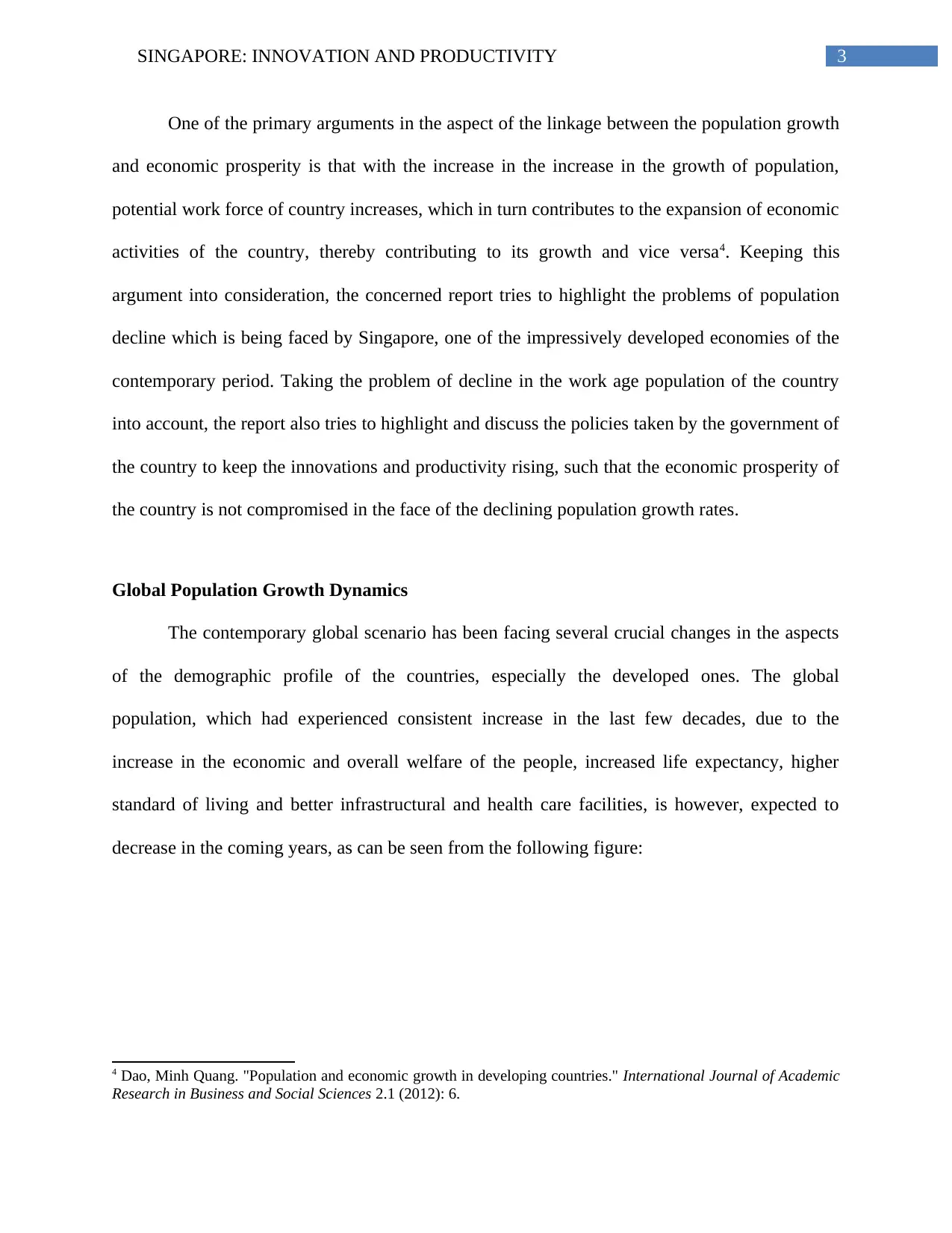
3SINGAPORE: INNOVATION AND PRODUCTIVITY
One of the primary arguments in the aspect of the linkage between the population growth
and economic prosperity is that with the increase in the increase in the growth of population,
potential work force of country increases, which in turn contributes to the expansion of economic
activities of the country, thereby contributing to its growth and vice versa4. Keeping this
argument into consideration, the concerned report tries to highlight the problems of population
decline which is being faced by Singapore, one of the impressively developed economies of the
contemporary period. Taking the problem of decline in the work age population of the country
into account, the report also tries to highlight and discuss the policies taken by the government of
the country to keep the innovations and productivity rising, such that the economic prosperity of
the country is not compromised in the face of the declining population growth rates.
Global Population Growth Dynamics
The contemporary global scenario has been facing several crucial changes in the aspects
of the demographic profile of the countries, especially the developed ones. The global
population, which had experienced consistent increase in the last few decades, due to the
increase in the economic and overall welfare of the people, increased life expectancy, higher
standard of living and better infrastructural and health care facilities, is however, expected to
decrease in the coming years, as can be seen from the following figure:
4 Dao, Minh Quang. "Population and economic growth in developing countries." International Journal of Academic
Research in Business and Social Sciences 2.1 (2012): 6.
One of the primary arguments in the aspect of the linkage between the population growth
and economic prosperity is that with the increase in the increase in the growth of population,
potential work force of country increases, which in turn contributes to the expansion of economic
activities of the country, thereby contributing to its growth and vice versa4. Keeping this
argument into consideration, the concerned report tries to highlight the problems of population
decline which is being faced by Singapore, one of the impressively developed economies of the
contemporary period. Taking the problem of decline in the work age population of the country
into account, the report also tries to highlight and discuss the policies taken by the government of
the country to keep the innovations and productivity rising, such that the economic prosperity of
the country is not compromised in the face of the declining population growth rates.
Global Population Growth Dynamics
The contemporary global scenario has been facing several crucial changes in the aspects
of the demographic profile of the countries, especially the developed ones. The global
population, which had experienced consistent increase in the last few decades, due to the
increase in the economic and overall welfare of the people, increased life expectancy, higher
standard of living and better infrastructural and health care facilities, is however, expected to
decrease in the coming years, as can be seen from the following figure:
4 Dao, Minh Quang. "Population and economic growth in developing countries." International Journal of Academic
Research in Business and Social Sciences 2.1 (2012): 6.
Paraphrase This Document
Need a fresh take? Get an instant paraphrase of this document with our AI Paraphraser
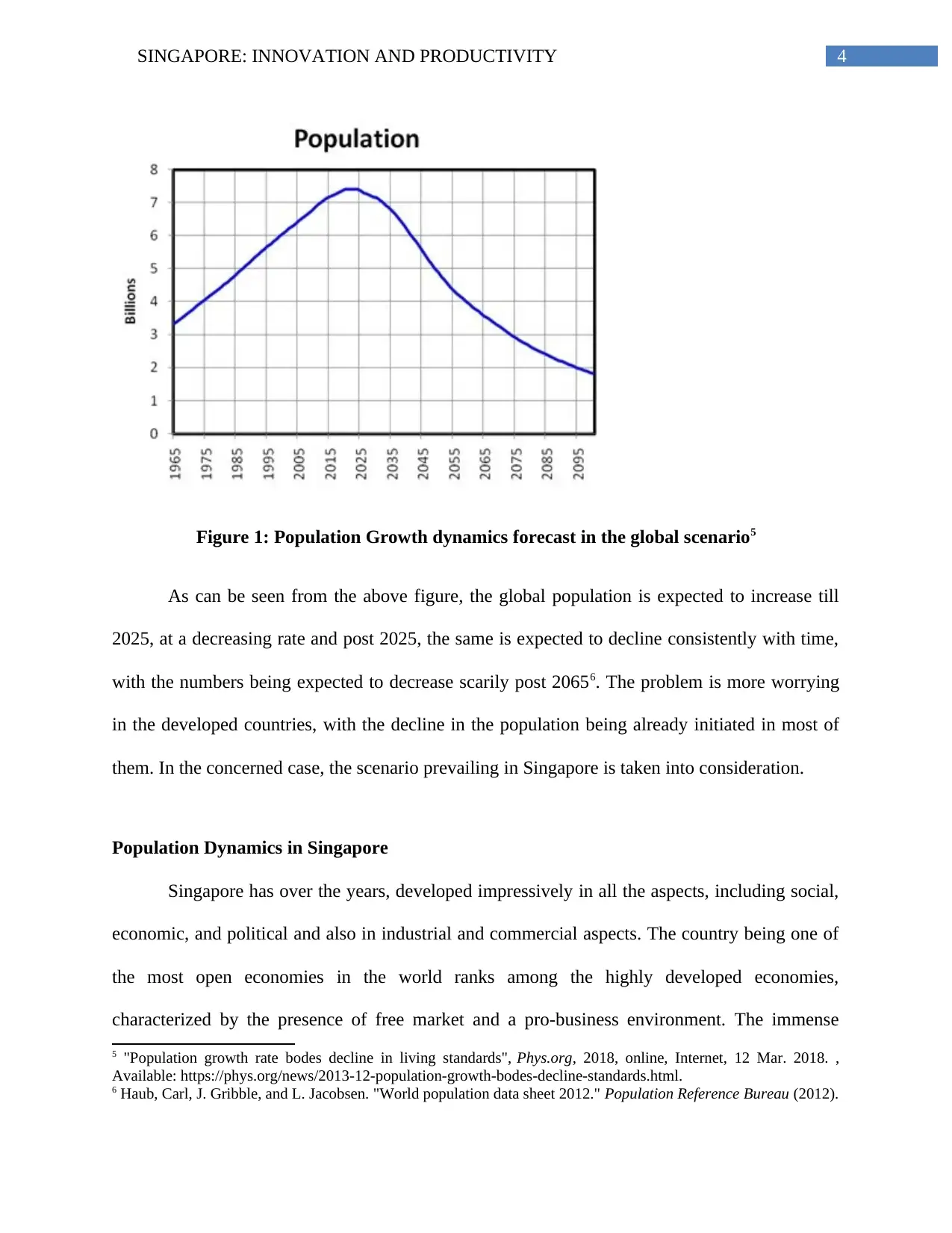
4SINGAPORE: INNOVATION AND PRODUCTIVITY
Figure 1: Population Growth dynamics forecast in the global scenario5
As can be seen from the above figure, the global population is expected to increase till
2025, at a decreasing rate and post 2025, the same is expected to decline consistently with time,
with the numbers being expected to decrease scarily post 20656. The problem is more worrying
in the developed countries, with the decline in the population being already initiated in most of
them. In the concerned case, the scenario prevailing in Singapore is taken into consideration.
Population Dynamics in Singapore
Singapore has over the years, developed impressively in all the aspects, including social,
economic, and political and also in industrial and commercial aspects. The country being one of
the most open economies in the world ranks among the highly developed economies,
characterized by the presence of free market and a pro-business environment. The immense
5 "Population growth rate bodes decline in living standards", Phys.org, 2018, online, Internet, 12 Mar. 2018. ,
Available: https://phys.org/news/2013-12-population-growth-bodes-decline-standards.html.
6 Haub, Carl, J. Gribble, and L. Jacobsen. "World population data sheet 2012." Population Reference Bureau (2012).
Figure 1: Population Growth dynamics forecast in the global scenario5
As can be seen from the above figure, the global population is expected to increase till
2025, at a decreasing rate and post 2025, the same is expected to decline consistently with time,
with the numbers being expected to decrease scarily post 20656. The problem is more worrying
in the developed countries, with the decline in the population being already initiated in most of
them. In the concerned case, the scenario prevailing in Singapore is taken into consideration.
Population Dynamics in Singapore
Singapore has over the years, developed impressively in all the aspects, including social,
economic, and political and also in industrial and commercial aspects. The country being one of
the most open economies in the world ranks among the highly developed economies,
characterized by the presence of free market and a pro-business environment. The immense
5 "Population growth rate bodes decline in living standards", Phys.org, 2018, online, Internet, 12 Mar. 2018. ,
Available: https://phys.org/news/2013-12-population-growth-bodes-decline-standards.html.
6 Haub, Carl, J. Gribble, and L. Jacobsen. "World population data sheet 2012." Population Reference Bureau (2012).
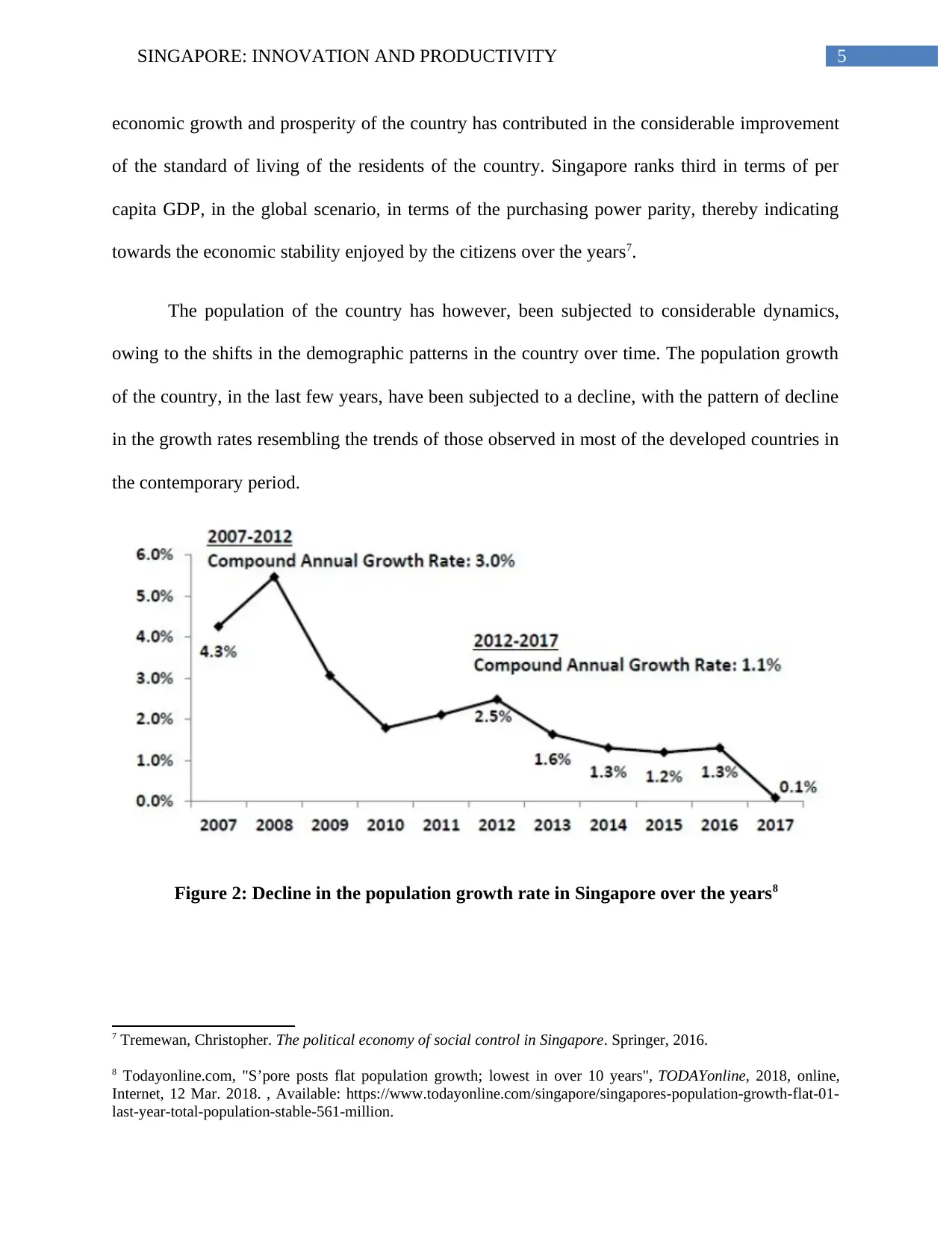
5SINGAPORE: INNOVATION AND PRODUCTIVITY
economic growth and prosperity of the country has contributed in the considerable improvement
of the standard of living of the residents of the country. Singapore ranks third in terms of per
capita GDP, in the global scenario, in terms of the purchasing power parity, thereby indicating
towards the economic stability enjoyed by the citizens over the years7.
The population of the country has however, been subjected to considerable dynamics,
owing to the shifts in the demographic patterns in the country over time. The population growth
of the country, in the last few years, have been subjected to a decline, with the pattern of decline
in the growth rates resembling the trends of those observed in most of the developed countries in
the contemporary period.
Figure 2: Decline in the population growth rate in Singapore over the years8
7 Tremewan, Christopher. The political economy of social control in Singapore. Springer, 2016.
8 Todayonline.com, "S’pore posts flat population growth; lowest in over 10 years", TODAYonline, 2018, online,
Internet, 12 Mar. 2018. , Available: https://www.todayonline.com/singapore/singapores-population-growth-flat-01-
last-year-total-population-stable-561-million.
economic growth and prosperity of the country has contributed in the considerable improvement
of the standard of living of the residents of the country. Singapore ranks third in terms of per
capita GDP, in the global scenario, in terms of the purchasing power parity, thereby indicating
towards the economic stability enjoyed by the citizens over the years7.
The population of the country has however, been subjected to considerable dynamics,
owing to the shifts in the demographic patterns in the country over time. The population growth
of the country, in the last few years, have been subjected to a decline, with the pattern of decline
in the growth rates resembling the trends of those observed in most of the developed countries in
the contemporary period.
Figure 2: Decline in the population growth rate in Singapore over the years8
7 Tremewan, Christopher. The political economy of social control in Singapore. Springer, 2016.
8 Todayonline.com, "S’pore posts flat population growth; lowest in over 10 years", TODAYonline, 2018, online,
Internet, 12 Mar. 2018. , Available: https://www.todayonline.com/singapore/singapores-population-growth-flat-01-
last-year-total-population-stable-561-million.
⊘ This is a preview!⊘
Do you want full access?
Subscribe today to unlock all pages.

Trusted by 1+ million students worldwide
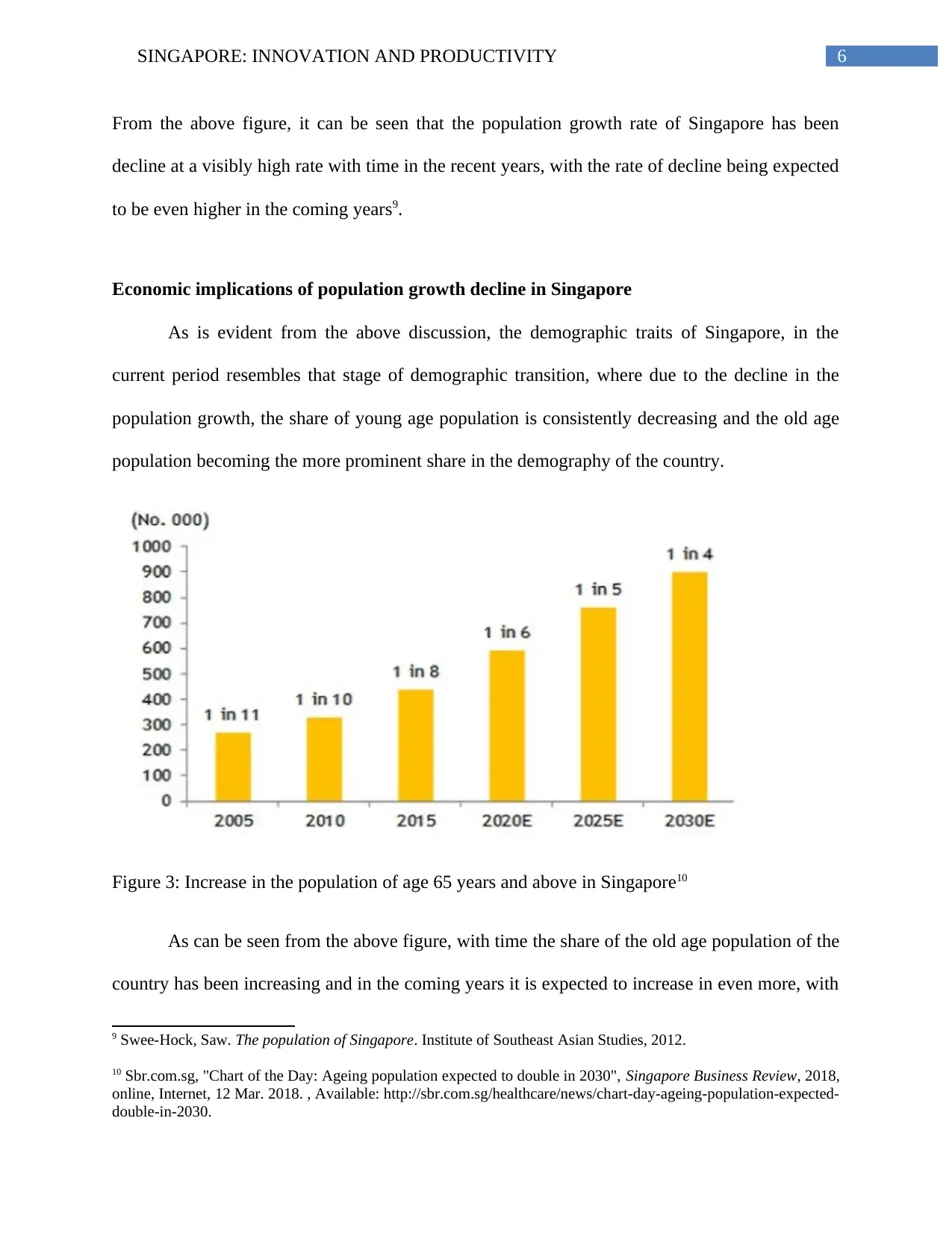
6SINGAPORE: INNOVATION AND PRODUCTIVITY
From the above figure, it can be seen that the population growth rate of Singapore has been
decline at a visibly high rate with time in the recent years, with the rate of decline being expected
to be even higher in the coming years9.
Economic implications of population growth decline in Singapore
As is evident from the above discussion, the demographic traits of Singapore, in the
current period resembles that stage of demographic transition, where due to the decline in the
population growth, the share of young age population is consistently decreasing and the old age
population becoming the more prominent share in the demography of the country.
Figure 3: Increase in the population of age 65 years and above in Singapore10
As can be seen from the above figure, with time the share of the old age population of the
country has been increasing and in the coming years it is expected to increase in even more, with
9 Swee-Hock, Saw. The population of Singapore. Institute of Southeast Asian Studies, 2012.
10 Sbr.com.sg, "Chart of the Day: Ageing population expected to double in 2030", Singapore Business Review, 2018,
online, Internet, 12 Mar. 2018. , Available: http://sbr.com.sg/healthcare/news/chart-day-ageing-population-expected-
double-in-2030.
From the above figure, it can be seen that the population growth rate of Singapore has been
decline at a visibly high rate with time in the recent years, with the rate of decline being expected
to be even higher in the coming years9.
Economic implications of population growth decline in Singapore
As is evident from the above discussion, the demographic traits of Singapore, in the
current period resembles that stage of demographic transition, where due to the decline in the
population growth, the share of young age population is consistently decreasing and the old age
population becoming the more prominent share in the demography of the country.
Figure 3: Increase in the population of age 65 years and above in Singapore10
As can be seen from the above figure, with time the share of the old age population of the
country has been increasing and in the coming years it is expected to increase in even more, with
9 Swee-Hock, Saw. The population of Singapore. Institute of Southeast Asian Studies, 2012.
10 Sbr.com.sg, "Chart of the Day: Ageing population expected to double in 2030", Singapore Business Review, 2018,
online, Internet, 12 Mar. 2018. , Available: http://sbr.com.sg/healthcare/news/chart-day-ageing-population-expected-
double-in-2030.
Paraphrase This Document
Need a fresh take? Get an instant paraphrase of this document with our AI Paraphraser
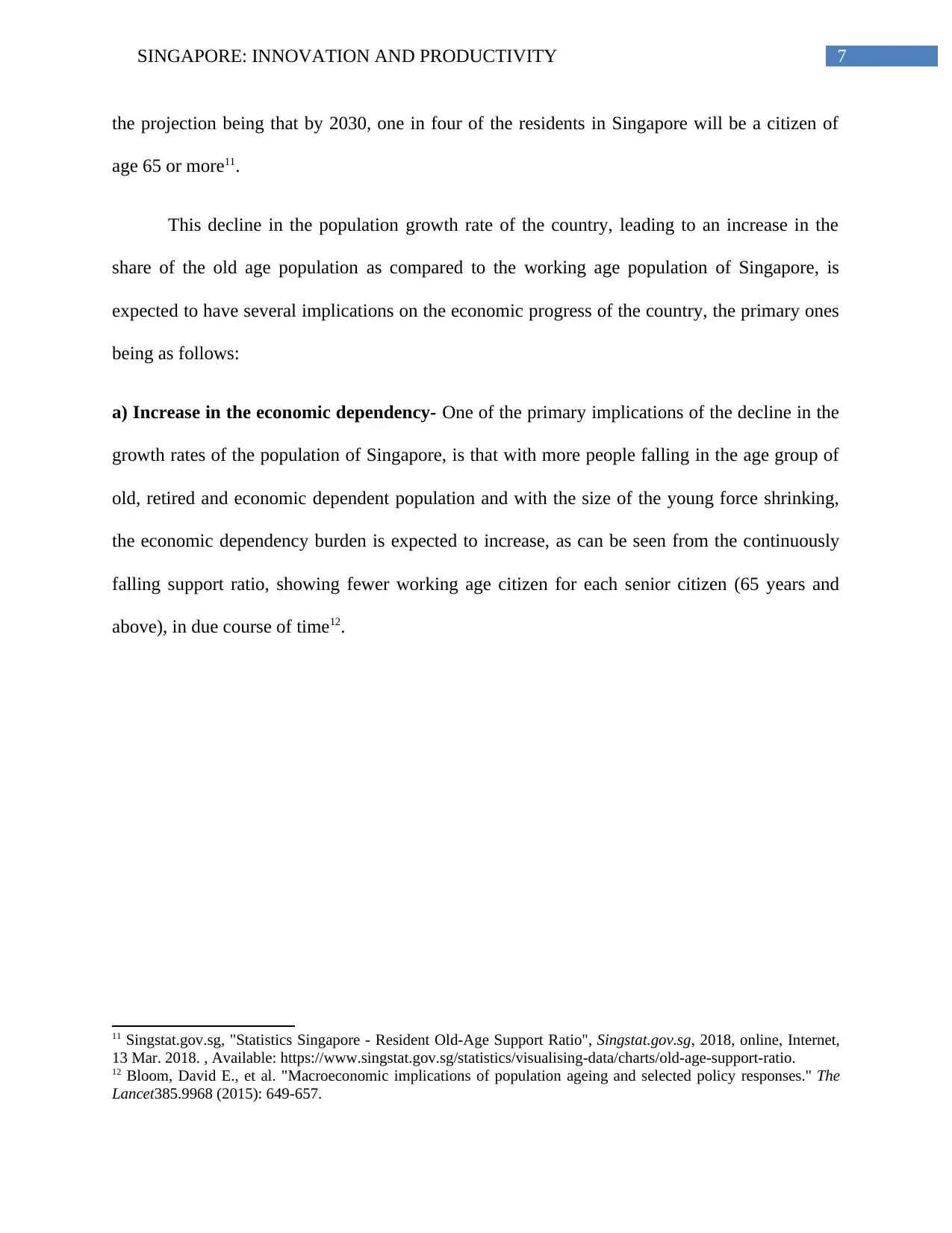
7SINGAPORE: INNOVATION AND PRODUCTIVITY
the projection being that by 2030, one in four of the residents in Singapore will be a citizen of
age 65 or more11.
This decline in the population growth rate of the country, leading to an increase in the
share of the old age population as compared to the working age population of Singapore, is
expected to have several implications on the economic progress of the country, the primary ones
being as follows:
a) Increase in the economic dependency- One of the primary implications of the decline in the
growth rates of the population of Singapore, is that with more people falling in the age group of
old, retired and economic dependent population and with the size of the young force shrinking,
the economic dependency burden is expected to increase, as can be seen from the continuously
falling support ratio, showing fewer working age citizen for each senior citizen (65 years and
above), in due course of time12.
11 Singstat.gov.sg, "Statistics Singapore - Resident Old-Age Support Ratio", Singstat.gov.sg, 2018, online, Internet,
13 Mar. 2018. , Available: https://www.singstat.gov.sg/statistics/visualising-data/charts/old-age-support-ratio.
12 Bloom, David E., et al. "Macroeconomic implications of population ageing and selected policy responses." The
Lancet385.9968 (2015): 649-657.
the projection being that by 2030, one in four of the residents in Singapore will be a citizen of
age 65 or more11.
This decline in the population growth rate of the country, leading to an increase in the
share of the old age population as compared to the working age population of Singapore, is
expected to have several implications on the economic progress of the country, the primary ones
being as follows:
a) Increase in the economic dependency- One of the primary implications of the decline in the
growth rates of the population of Singapore, is that with more people falling in the age group of
old, retired and economic dependent population and with the size of the young force shrinking,
the economic dependency burden is expected to increase, as can be seen from the continuously
falling support ratio, showing fewer working age citizen for each senior citizen (65 years and
above), in due course of time12.
11 Singstat.gov.sg, "Statistics Singapore - Resident Old-Age Support Ratio", Singstat.gov.sg, 2018, online, Internet,
13 Mar. 2018. , Available: https://www.singstat.gov.sg/statistics/visualising-data/charts/old-age-support-ratio.
12 Bloom, David E., et al. "Macroeconomic implications of population ageing and selected policy responses." The
Lancet385.9968 (2015): 649-657.
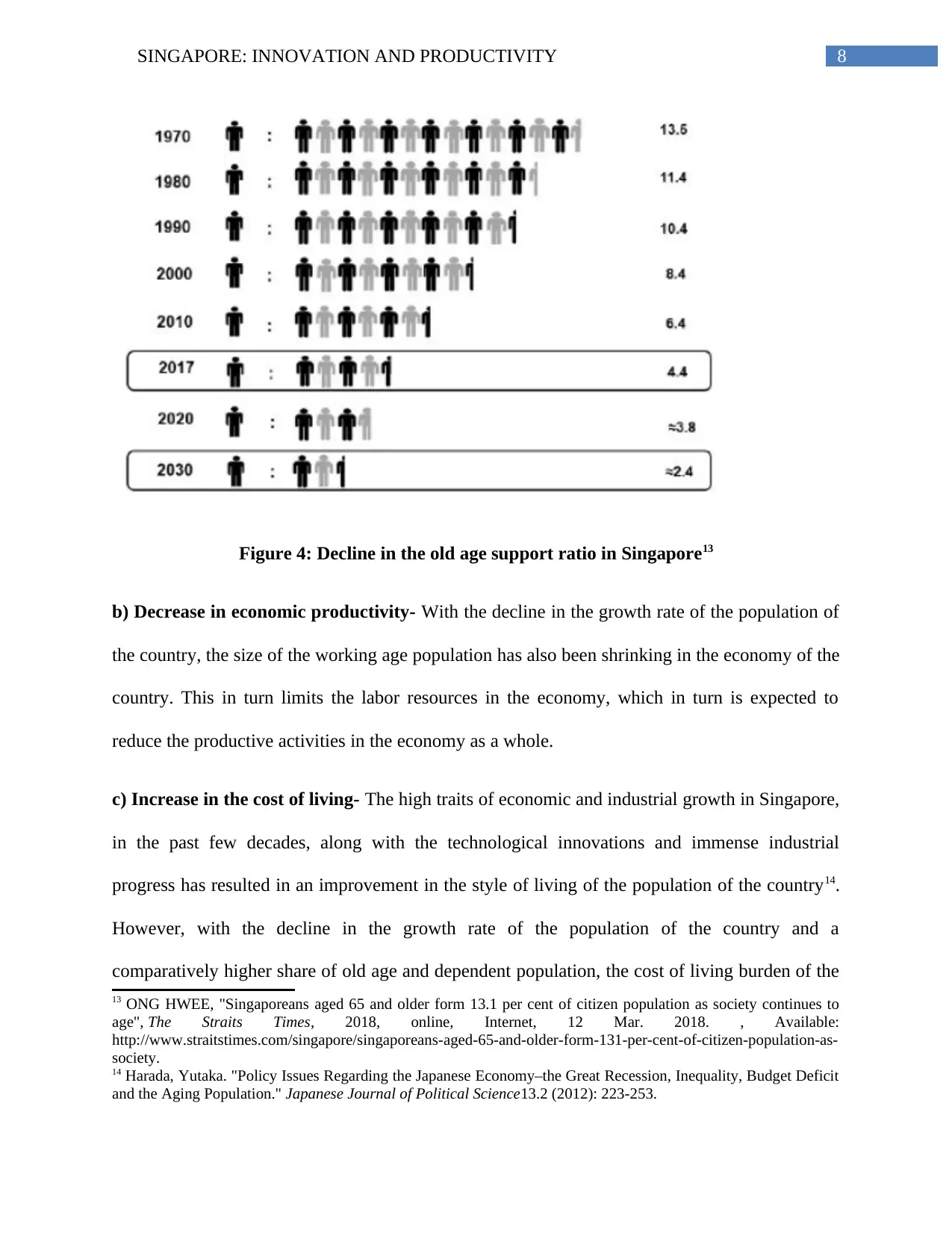
8SINGAPORE: INNOVATION AND PRODUCTIVITY
Figure 4: Decline in the old age support ratio in Singapore13
b) Decrease in economic productivity- With the decline in the growth rate of the population of
the country, the size of the working age population has also been shrinking in the economy of the
country. This in turn limits the labor resources in the economy, which in turn is expected to
reduce the productive activities in the economy as a whole.
c) Increase in the cost of living- The high traits of economic and industrial growth in Singapore,
in the past few decades, along with the technological innovations and immense industrial
progress has resulted in an improvement in the style of living of the population of the country14.
However, with the decline in the growth rate of the population of the country and a
comparatively higher share of old age and dependent population, the cost of living burden of the
13 ONG HWEE, "Singaporeans aged 65 and older form 13.1 per cent of citizen population as society continues to
age", The Straits Times, 2018, online, Internet, 12 Mar. 2018. , Available:
http://www.straitstimes.com/singapore/singaporeans-aged-65-and-older-form-131-per-cent-of-citizen-population-as-
society.
14 Harada, Yutaka. "Policy Issues Regarding the Japanese Economy–the Great Recession, Inequality, Budget Deficit
and the Aging Population." Japanese Journal of Political Science13.2 (2012): 223-253.
Figure 4: Decline in the old age support ratio in Singapore13
b) Decrease in economic productivity- With the decline in the growth rate of the population of
the country, the size of the working age population has also been shrinking in the economy of the
country. This in turn limits the labor resources in the economy, which in turn is expected to
reduce the productive activities in the economy as a whole.
c) Increase in the cost of living- The high traits of economic and industrial growth in Singapore,
in the past few decades, along with the technological innovations and immense industrial
progress has resulted in an improvement in the style of living of the population of the country14.
However, with the decline in the growth rate of the population of the country and a
comparatively higher share of old age and dependent population, the cost of living burden of the
13 ONG HWEE, "Singaporeans aged 65 and older form 13.1 per cent of citizen population as society continues to
age", The Straits Times, 2018, online, Internet, 12 Mar. 2018. , Available:
http://www.straitstimes.com/singapore/singaporeans-aged-65-and-older-form-131-per-cent-of-citizen-population-as-
society.
14 Harada, Yutaka. "Policy Issues Regarding the Japanese Economy–the Great Recession, Inequality, Budget Deficit
and the Aging Population." Japanese Journal of Political Science13.2 (2012): 223-253.
⊘ This is a preview!⊘
Do you want full access?
Subscribe today to unlock all pages.

Trusted by 1+ million students worldwide
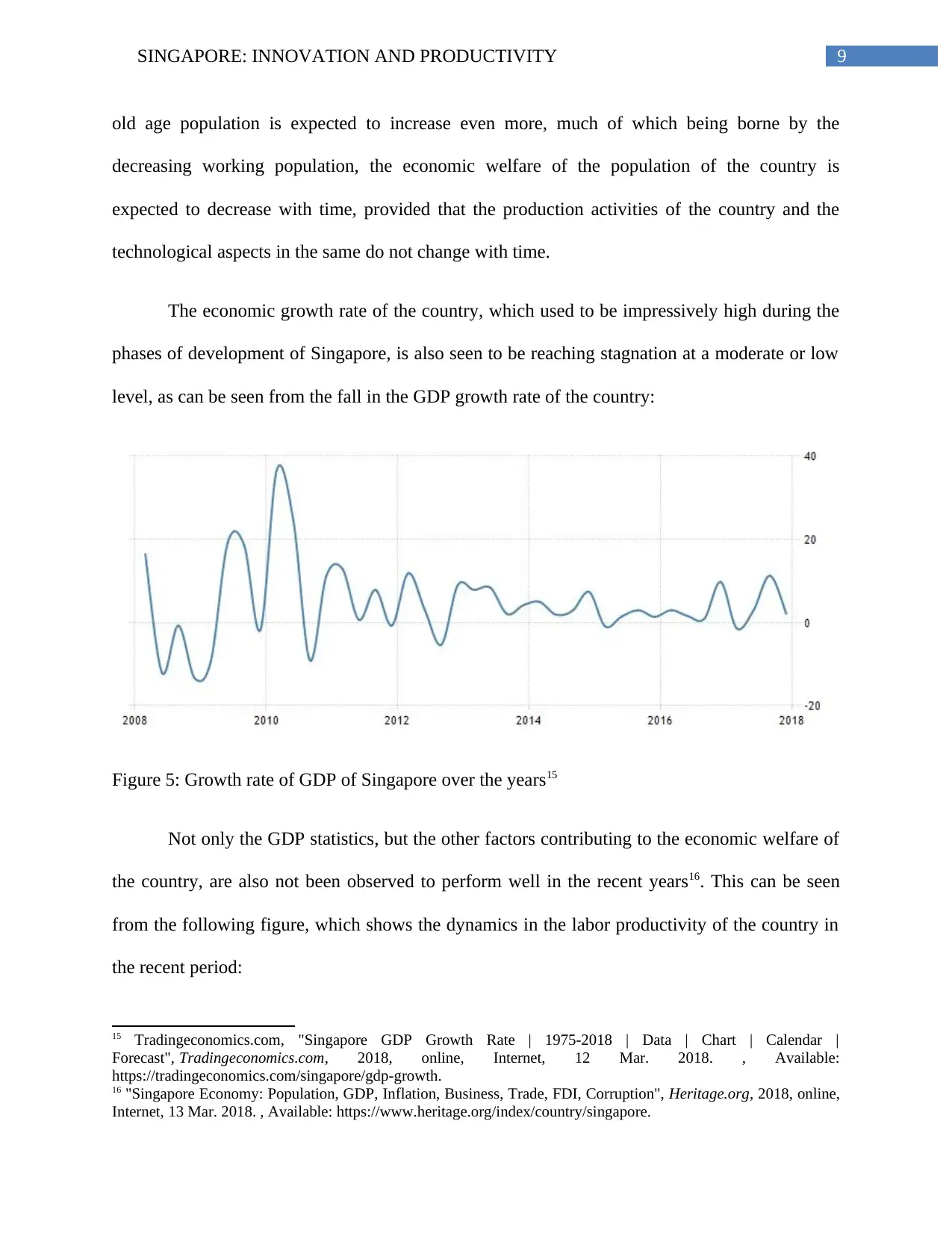
9SINGAPORE: INNOVATION AND PRODUCTIVITY
old age population is expected to increase even more, much of which being borne by the
decreasing working population, the economic welfare of the population of the country is
expected to decrease with time, provided that the production activities of the country and the
technological aspects in the same do not change with time.
The economic growth rate of the country, which used to be impressively high during the
phases of development of Singapore, is also seen to be reaching stagnation at a moderate or low
level, as can be seen from the fall in the GDP growth rate of the country:
Figure 5: Growth rate of GDP of Singapore over the years15
Not only the GDP statistics, but the other factors contributing to the economic welfare of
the country, are also not been observed to perform well in the recent years16. This can be seen
from the following figure, which shows the dynamics in the labor productivity of the country in
the recent period:
15 Tradingeconomics.com, "Singapore GDP Growth Rate | 1975-2018 | Data | Chart | Calendar |
Forecast", Tradingeconomics.com, 2018, online, Internet, 12 Mar. 2018. , Available:
https://tradingeconomics.com/singapore/gdp-growth.
16 "Singapore Economy: Population, GDP, Inflation, Business, Trade, FDI, Corruption", Heritage.org, 2018, online,
Internet, 13 Mar. 2018. , Available: https://www.heritage.org/index/country/singapore.
old age population is expected to increase even more, much of which being borne by the
decreasing working population, the economic welfare of the population of the country is
expected to decrease with time, provided that the production activities of the country and the
technological aspects in the same do not change with time.
The economic growth rate of the country, which used to be impressively high during the
phases of development of Singapore, is also seen to be reaching stagnation at a moderate or low
level, as can be seen from the fall in the GDP growth rate of the country:
Figure 5: Growth rate of GDP of Singapore over the years15
Not only the GDP statistics, but the other factors contributing to the economic welfare of
the country, are also not been observed to perform well in the recent years16. This can be seen
from the following figure, which shows the dynamics in the labor productivity of the country in
the recent period:
15 Tradingeconomics.com, "Singapore GDP Growth Rate | 1975-2018 | Data | Chart | Calendar |
Forecast", Tradingeconomics.com, 2018, online, Internet, 12 Mar. 2018. , Available:
https://tradingeconomics.com/singapore/gdp-growth.
16 "Singapore Economy: Population, GDP, Inflation, Business, Trade, FDI, Corruption", Heritage.org, 2018, online,
Internet, 13 Mar. 2018. , Available: https://www.heritage.org/index/country/singapore.
Paraphrase This Document
Need a fresh take? Get an instant paraphrase of this document with our AI Paraphraser
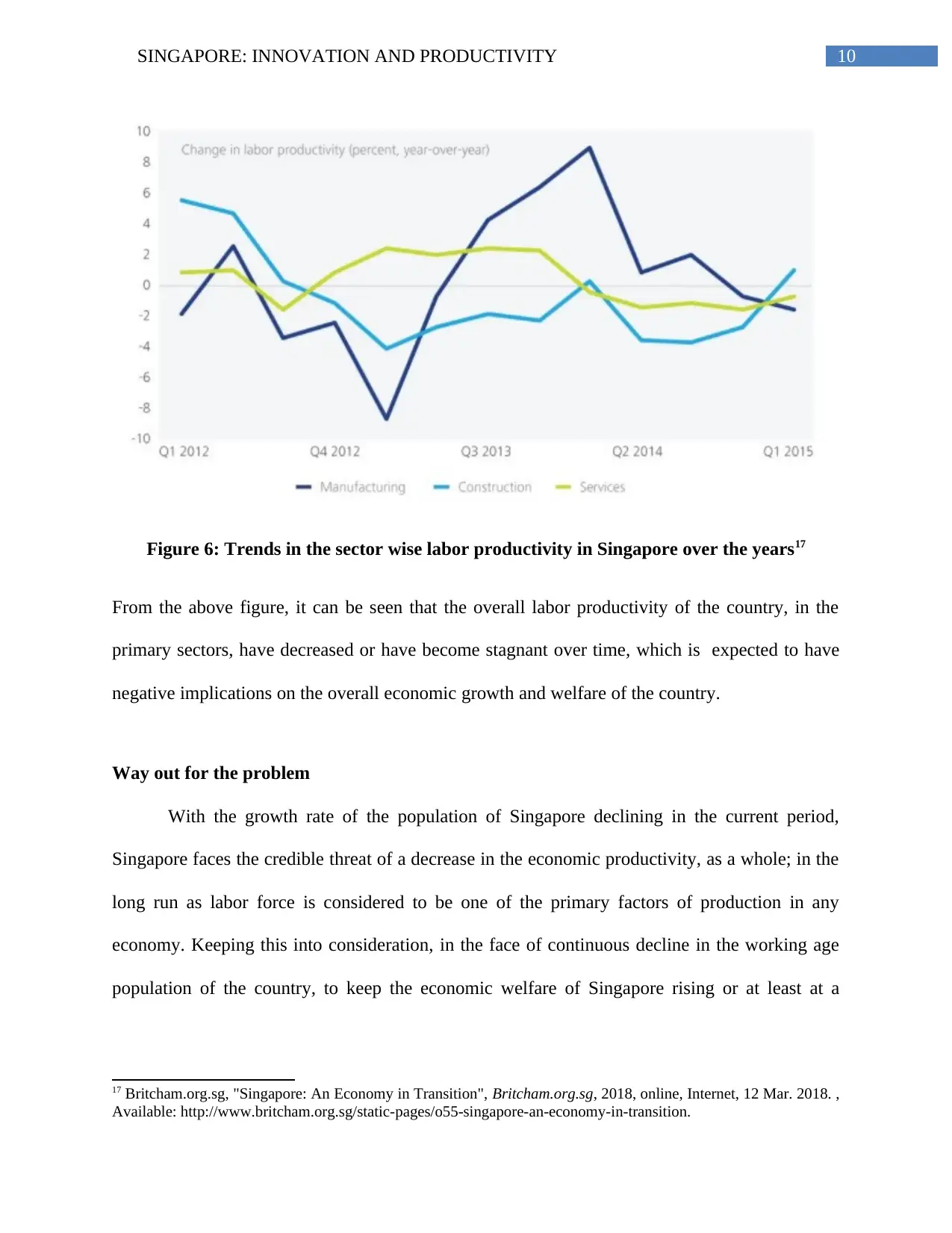
10SINGAPORE: INNOVATION AND PRODUCTIVITY
Figure 6: Trends in the sector wise labor productivity in Singapore over the years17
From the above figure, it can be seen that the overall labor productivity of the country, in the
primary sectors, have decreased or have become stagnant over time, which is expected to have
negative implications on the overall economic growth and welfare of the country.
Way out for the problem
With the growth rate of the population of Singapore declining in the current period,
Singapore faces the credible threat of a decrease in the economic productivity, as a whole; in the
long run as labor force is considered to be one of the primary factors of production in any
economy. Keeping this into consideration, in the face of continuous decline in the working age
population of the country, to keep the economic welfare of Singapore rising or at least at a
17 Britcham.org.sg, "Singapore: An Economy in Transition", Britcham.org.sg, 2018, online, Internet, 12 Mar. 2018. ,
Available: http://www.britcham.org.sg/static-pages/o55-singapore-an-economy-in-transition.
Figure 6: Trends in the sector wise labor productivity in Singapore over the years17
From the above figure, it can be seen that the overall labor productivity of the country, in the
primary sectors, have decreased or have become stagnant over time, which is expected to have
negative implications on the overall economic growth and welfare of the country.
Way out for the problem
With the growth rate of the population of Singapore declining in the current period,
Singapore faces the credible threat of a decrease in the economic productivity, as a whole; in the
long run as labor force is considered to be one of the primary factors of production in any
economy. Keeping this into consideration, in the face of continuous decline in the working age
population of the country, to keep the economic welfare of Singapore rising or at least at a
17 Britcham.org.sg, "Singapore: An Economy in Transition", Britcham.org.sg, 2018, online, Internet, 12 Mar. 2018. ,
Available: http://www.britcham.org.sg/static-pages/o55-singapore-an-economy-in-transition.
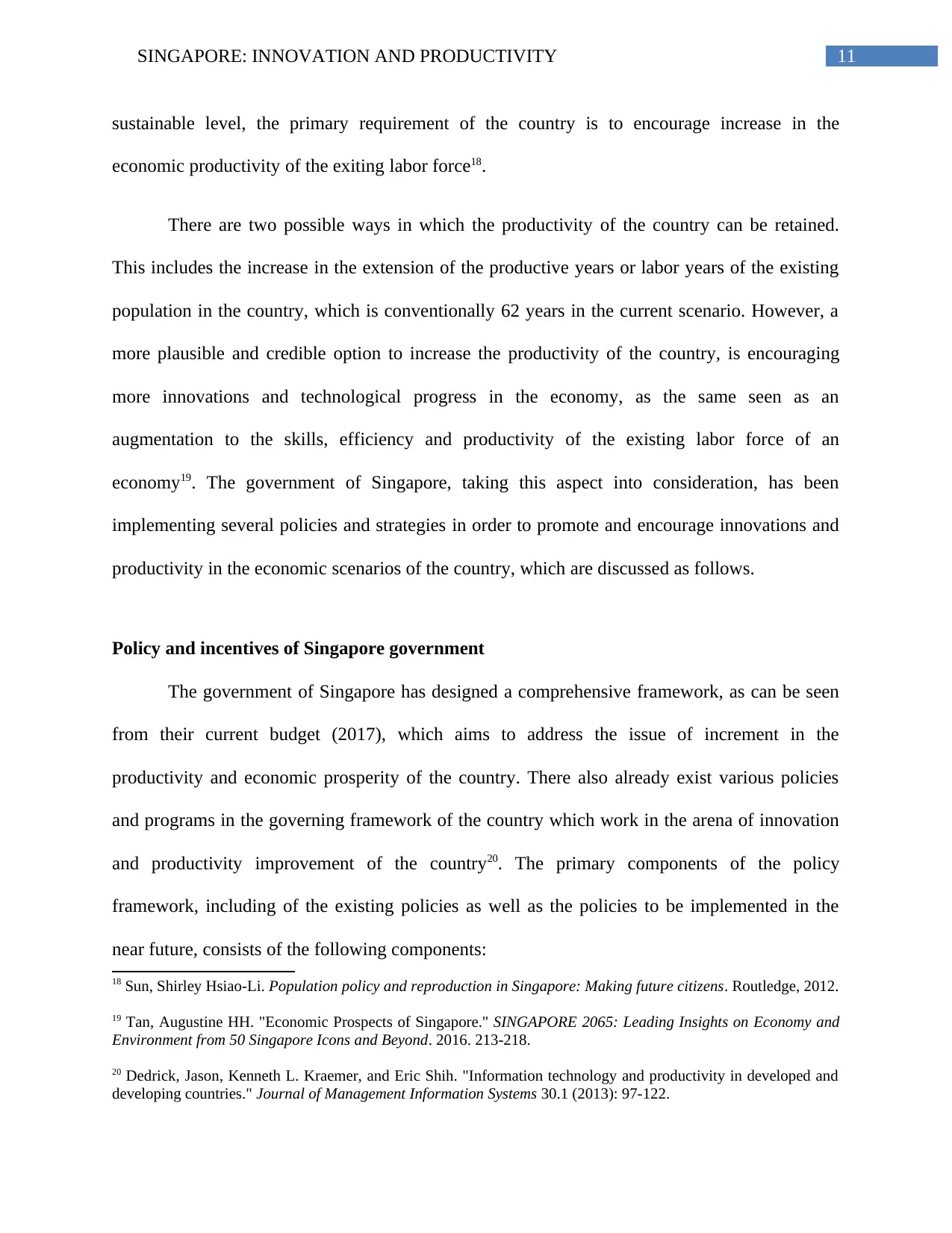
11SINGAPORE: INNOVATION AND PRODUCTIVITY
sustainable level, the primary requirement of the country is to encourage increase in the
economic productivity of the exiting labor force18.
There are two possible ways in which the productivity of the country can be retained.
This includes the increase in the extension of the productive years or labor years of the existing
population in the country, which is conventionally 62 years in the current scenario. However, a
more plausible and credible option to increase the productivity of the country, is encouraging
more innovations and technological progress in the economy, as the same seen as an
augmentation to the skills, efficiency and productivity of the existing labor force of an
economy19. The government of Singapore, taking this aspect into consideration, has been
implementing several policies and strategies in order to promote and encourage innovations and
productivity in the economic scenarios of the country, which are discussed as follows.
Policy and incentives of Singapore government
The government of Singapore has designed a comprehensive framework, as can be seen
from their current budget (2017), which aims to address the issue of increment in the
productivity and economic prosperity of the country. There also already exist various policies
and programs in the governing framework of the country which work in the arena of innovation
and productivity improvement of the country20. The primary components of the policy
framework, including of the existing policies as well as the policies to be implemented in the
near future, consists of the following components:
18 Sun, Shirley Hsiao-Li. Population policy and reproduction in Singapore: Making future citizens. Routledge, 2012.
19 Tan, Augustine HH. "Economic Prospects of Singapore." SINGAPORE 2065: Leading Insights on Economy and
Environment from 50 Singapore Icons and Beyond. 2016. 213-218.
20 Dedrick, Jason, Kenneth L. Kraemer, and Eric Shih. "Information technology and productivity in developed and
developing countries." Journal of Management Information Systems 30.1 (2013): 97-122.
sustainable level, the primary requirement of the country is to encourage increase in the
economic productivity of the exiting labor force18.
There are two possible ways in which the productivity of the country can be retained.
This includes the increase in the extension of the productive years or labor years of the existing
population in the country, which is conventionally 62 years in the current scenario. However, a
more plausible and credible option to increase the productivity of the country, is encouraging
more innovations and technological progress in the economy, as the same seen as an
augmentation to the skills, efficiency and productivity of the existing labor force of an
economy19. The government of Singapore, taking this aspect into consideration, has been
implementing several policies and strategies in order to promote and encourage innovations and
productivity in the economic scenarios of the country, which are discussed as follows.
Policy and incentives of Singapore government
The government of Singapore has designed a comprehensive framework, as can be seen
from their current budget (2017), which aims to address the issue of increment in the
productivity and economic prosperity of the country. There also already exist various policies
and programs in the governing framework of the country which work in the arena of innovation
and productivity improvement of the country20. The primary components of the policy
framework, including of the existing policies as well as the policies to be implemented in the
near future, consists of the following components:
18 Sun, Shirley Hsiao-Li. Population policy and reproduction in Singapore: Making future citizens. Routledge, 2012.
19 Tan, Augustine HH. "Economic Prospects of Singapore." SINGAPORE 2065: Leading Insights on Economy and
Environment from 50 Singapore Icons and Beyond. 2016. 213-218.
20 Dedrick, Jason, Kenneth L. Kraemer, and Eric Shih. "Information technology and productivity in developed and
developing countries." Journal of Management Information Systems 30.1 (2013): 97-122.
⊘ This is a preview!⊘
Do you want full access?
Subscribe today to unlock all pages.

Trusted by 1+ million students worldwide
1 out of 21
Related Documents
Your All-in-One AI-Powered Toolkit for Academic Success.
+13062052269
info@desklib.com
Available 24*7 on WhatsApp / Email
![[object Object]](/_next/static/media/star-bottom.7253800d.svg)
Unlock your academic potential
Copyright © 2020–2025 A2Z Services. All Rights Reserved. Developed and managed by ZUCOL.





